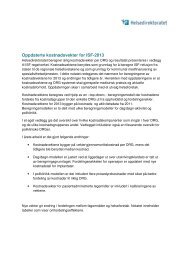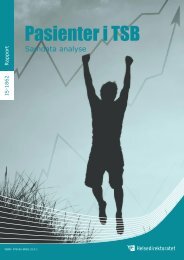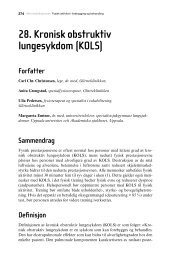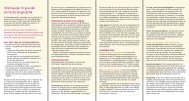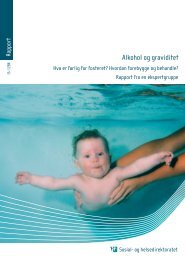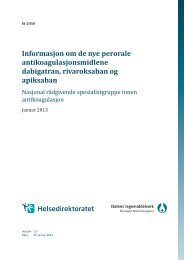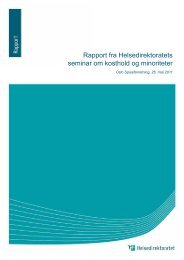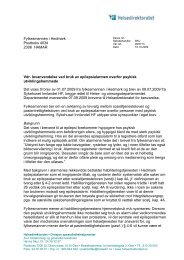Norway and Health an introduction - Helsedirektoratet
Norway and Health an introduction - Helsedirektoratet
Norway and Health an introduction - Helsedirektoratet
Create successful ePaper yourself
Turn your PDF publications into a flip-book with our unique Google optimized e-Paper software.
IS-1730 E<br />
<strong>Norway</strong> <strong><strong>an</strong>d</strong> <strong>Health</strong><br />
<strong>an</strong> <strong>introduction</strong>
Title: <strong>Norway</strong> <strong><strong>an</strong>d</strong> <strong>Health</strong>. An <strong>introduction</strong>.<br />
.<br />
Published: 04/2009<br />
Reference Number: IS-1730 E<br />
Published by: Norwegi<strong>an</strong> Directorate of <strong>Health</strong><br />
Contact: Secretariat for International Cooperation<br />
Postal adress: Pb. 7000 St Olavs plass, 0130 Oslo<br />
Visiting adress: Universitetsgata 2, Oslo<br />
Tel: 810 20 050<br />
Fax: 24 16 30 01<br />
www.helsedirektoratet.no<br />
This booklet may beordered at:<br />
Norwegi<strong>an</strong> Directorate of <strong>Health</strong><br />
att. “Trykksaksekspedisjonen”<br />
e-mail: trykksak@helsedir.no<br />
We are pl<strong>an</strong>ning to update this publication at regular intervals.<br />
Please send your comments to: f-arkivar@helsedir.no,<br />
att. ”Secretariat for International Cooperation”.<br />
Editorial Team: Sigurd Røed Dahl<br />
Lal M<strong>an</strong>avado<br />
Øydis Monsen<br />
Harald Siem<br />
Subject contributors: Bente Hatling, Hospital Services<br />
Bente Moe, Community <strong>Health</strong> Services<br />
Bente Nystad, Care <strong><strong>an</strong>d</strong> Dental <strong>Health</strong> Services<br />
Freja U. Kärki, Mental <strong>Health</strong><br />
Gabrielle Katrine Welle-Str<strong><strong>an</strong>d</strong>, Subst<strong>an</strong>ce Abuse<br />
Heidi Tomten, Physical Activity<br />
Kaja Lund-Iversen, Nutrition<br />
Katrine S. Edvardsen, Medical Devices <strong><strong>an</strong>d</strong> Medical Products<br />
Linda Haugen, <strong>Health</strong> <strong><strong>an</strong>d</strong> Social Services Personnel<br />
Michael Kaurin, <strong>Health</strong> Statistics<br />
Øyvind Christensen, Norwegi<strong>an</strong> Patient Register Department<br />
Ragnar Salmén, Emergency Preparedness<br />
Rita Lill Lindbak, Tobacco<br />
Tone P. Torgersen, Environmental <strong>Health</strong><br />
Toril Laberg, Delta Centre
Preface<br />
There has been a growing interest abroad in the Norwegi<strong>an</strong> health <strong><strong>an</strong>d</strong> care services. This booklet<br />
outlines the structure <strong><strong>an</strong>d</strong> some key factors that shaped the system into what it is today.<br />
It is firmly <strong>an</strong>chored in the Norwegi<strong>an</strong> traditional political tenet that society is collectively responsible<br />
for the welfare of its citizens. Thus, <strong>an</strong> overarching aim is to provide services of high quality,<br />
available within acceptable waiting times <strong><strong>an</strong>d</strong> dist<strong>an</strong>ces, reaching out to everyone regardless of their<br />
fin<strong>an</strong>cial situation, social status, age, gender <strong><strong>an</strong>d</strong> ethnic background.<br />
During the last four decades, <strong>Norway</strong> has undergone a subst<strong>an</strong>tial socio-economic tr<strong>an</strong>sformation, <strong><strong>an</strong>d</strong><br />
is now among the wealthiest nations in the world. This development has been of great signific<strong>an</strong>ce<br />
to the health status of the nation, the services provided <strong><strong>an</strong>d</strong> the public expectations of the health<br />
services.<br />
A national health system is the result of a dynamic interplay between health needs, public expectations,<br />
professions, interest groups <strong><strong>an</strong>d</strong> available resources. As all these elements ch<strong>an</strong>ge over time,<br />
the system is in const<strong>an</strong>t evolution.<br />
To be adequate, a health system in evolution has to contain mech<strong>an</strong>isms for priority <strong><strong>an</strong>d</strong> capacity<br />
revision, quality assur<strong>an</strong>ce, structural adjustment, <strong><strong>an</strong>d</strong> optimal resource utilisation. One major concern<br />
in <strong>Norway</strong> as <strong>an</strong> egalitari<strong>an</strong> society is the growing disparity in health between social groups, in spite<br />
of universal access to care <strong><strong>an</strong>d</strong> services. A comprehensive policy on social determin<strong>an</strong>ts of health is<br />
developed in order to reduce social inequalities in health.<br />
The principal elements of the structure <strong><strong>an</strong>d</strong> activities are outlined here, with a slight bias to the work<br />
under the responsibility of the Norwegi<strong>an</strong> Directorate of <strong>Health</strong>. There have been m<strong>an</strong>y contributors,<br />
which is apparent in the variation in writing style of the chapters. A special note of gratitude goes to<br />
Lal M<strong>an</strong>avado, who initiated this project <strong><strong>an</strong>d</strong> contributed extensively throughout the process.<br />
We hope this booklet will give you a quick overview that you will find interesting, informative <strong><strong>an</strong>d</strong> useful<br />
as a first <strong>introduction</strong> to health in <strong>Norway</strong>.<br />
Bjørn-Inge Larsen<br />
Director General<br />
Bjørn-Inge Larsen, (MD, BC, MBA, MPH), is a member (<strong><strong>an</strong>d</strong> chair 2009) of WHO St<strong><strong>an</strong>d</strong>ing Committee<br />
of the Regional Committee for Europe for the period 2006-2009.
2<br />
Contents<br />
Preface 1<br />
1 International cooperation on health 4<br />
2 <strong>Norway</strong>, the nation 5<br />
2.1 Geography 5<br />
2.2 Demography (2007) 7<br />
2.3 Government 8<br />
2.4 Economy 9<br />
2.5 <strong>Health</strong> 9<br />
3 <strong>Health</strong>: Fin<strong>an</strong>cial <strong><strong>an</strong>d</strong> hum<strong>an</strong> resources 11<br />
3.1 M<strong>an</strong>power 12<br />
3.2 Registration/licensing of personnel 12<br />
4 <strong>Health</strong> m<strong>an</strong>agement 14<br />
4.1 <strong>Health</strong> at the national level 14<br />
4.2 <strong>Health</strong> at the provincial level 17<br />
4.3 <strong>Health</strong> at the local level 17<br />
5 Primary health services 18<br />
5.1 Scope 18<br />
5.2 Roles 18<br />
5.3 Fin<strong>an</strong>cing 18<br />
5.4 The general practitioners’ scheme 19<br />
5.5 The health clinics 19<br />
5.6 <strong>Health</strong> <strong><strong>an</strong>d</strong> care services for the elderly <strong><strong>an</strong>d</strong> disabled 20<br />
5.6.1 Users 20<br />
5.6.2 Personnel 20<br />
5.7 Public dental health services 20<br />
5.7.1 Frequency of use 21<br />
5.7.2 Costs 21
6 Specialist health care services 22<br />
6.1 <strong>Health</strong> enterprises 23<br />
6.2 Allocations 23<br />
6.3 Patients rights 24<br />
6.4 Priority-setting 25<br />
6.5 Pharmaceuticals safe use 25<br />
6.6 Mental health services 25<br />
6.7 Alcohol <strong><strong>an</strong>d</strong> drug abuse 27<br />
6.7.1 Main goals 27<br />
6.7.2 Treatment 27<br />
7 Public health <strong><strong>an</strong>d</strong> health promotion 29<br />
7.1 Strategy to reduce social inequalities in health 29<br />
7.2 Tobacco use <strong><strong>an</strong>d</strong> tobacco control 29<br />
7.2.1 Strong legislation 30<br />
7.2.2 Reducing use 30<br />
7.3 Nutrition 31<br />
7.4 Physical activity 33<br />
8 Universal design - The Delta centre 34<br />
9 Preparedness 34<br />
9.1 Aims 34<br />
Links<br />
3
4<br />
1 International cooperation on health<br />
<strong>Norway</strong> is <strong>an</strong> active particip<strong>an</strong>t in the international efforts to enh<strong>an</strong>ce global public<br />
health. Over the years, <strong>Norway</strong> has seen the World <strong>Health</strong> Org<strong>an</strong>ization (WHO) as the<br />
central arena for international health. Karl Ev<strong>an</strong>g, former Director of health, was one<br />
of the founders of the org<strong>an</strong>ization in 1948, while former Prime Minister Gro Harlem<br />
Brundtl<strong><strong>an</strong>d</strong> served as Director General from 1998 to 2003.<br />
The Director of health, Bjørn-Inge Larsen, is a member (<strong><strong>an</strong>d</strong> chair 2009) of WHO St<strong><strong>an</strong>d</strong>ing<br />
Committee of the Regional Committee for Europe for the period 2006-2009.<br />
Prime Minister Jens Stoltenberg (2005-) has been actively involved in UN-reform <strong><strong>an</strong>d</strong> the<br />
intensified campaign to meet the Millennium Development Goals four <strong><strong>an</strong>d</strong> five by 2015.<br />
Minister of Foreign Affairs, Jonas Gahr Støre, has in collaboration with six other Ministers<br />
of Foreign Affairs initiated a process of looking at health <strong><strong>an</strong>d</strong> diplomacy, to explore<br />
the areas where foreign affairs cover global health issues. This embraces threats like<br />
p<strong><strong>an</strong>d</strong>emics, trade issues like patent rights <strong><strong>an</strong>d</strong> the cost of essential treatment in poor<br />
countries, as well as responsible recruitment of health personnel. Last but not least,<br />
reconstruction of failed states <strong><strong>an</strong>d</strong> hum<strong>an</strong>itari<strong>an</strong> assist<strong>an</strong>ce in emergencies shall also be<br />
added to these issues.<br />
Mention must also be made of regional health cooperation. Collaboration with the Nordic<br />
<strong><strong>an</strong>d</strong> Baltic States, as well as Russia, is given high priority. The latter in particular has<br />
seen a dramatic upturn since the early nineties. M<strong>an</strong>y health projects <strong><strong>an</strong>d</strong> programs<br />
related to tuberculosis control, prevention of HIV-infections, child health care <strong><strong>an</strong>d</strong> prevention<br />
of lifestyle-related disease, have been carried out.<br />
The EU plays a signific<strong>an</strong>t role in Europe<strong>an</strong> health cooperation, <strong><strong>an</strong>d</strong> although not <strong>an</strong><br />
EU-member, <strong>Norway</strong> is involved in a variety of EU activities. A large number of EU directives<br />
are implemented in <strong>Norway</strong>. This is particularly true in the field of food safety.<br />
Other areas of cooperation include health preparedness, cross-border patient mobility<br />
<strong><strong>an</strong>d</strong> participation in EU-programmes. <strong>Norway</strong> also participates in four health-related<br />
EU-agencies: Europe<strong>an</strong> Medicines Agency (EMEA), Europe<strong>an</strong> Centre for Disease Prevention<br />
<strong><strong>an</strong>d</strong> Control (ECDC), Europe<strong>an</strong> Monitoring Centre for Drugs <strong><strong>an</strong>d</strong> Drug Addiction (EMCDDA)<br />
<strong><strong>an</strong>d</strong> the Europe<strong>an</strong> Food Safety Authority (EFSA).
2 <strong>Norway</strong>, the nation<br />
<strong>Norway</strong> is a founding member of the United Nations, NATO <strong><strong>an</strong>d</strong> the Council of<br />
Europe, but is not a member of the Europe<strong>an</strong> Union (EU). Norwegi<strong>an</strong> voters turned<br />
down EU membership by narrow margins in 1972 <strong><strong>an</strong>d</strong> 1994. However, <strong>Norway</strong> is<br />
part of the EU internal market, <strong><strong>an</strong>d</strong> has <strong>an</strong> extensive cooperation on most policy<br />
areas through the Europe<strong>an</strong> Economic Area (EEA) agreement.<br />
2.1 Geography<br />
<strong>Norway</strong> is located in Northern Europe, bordering the North Sea <strong><strong>an</strong>d</strong> the North<br />
Atl<strong>an</strong>tic Oce<strong>an</strong>. Half the country lies north of the Polar Circle. It borders Sweden,<br />
Finl<strong><strong>an</strong>d</strong> <strong><strong>an</strong>d</strong> the Russi<strong>an</strong> Federation.<br />
The country is divided into 19 regional authority areas, counties (fylker), which<br />
in turn are divided into more th<strong>an</strong> 430 local authority areas, municipalities (kommuner).<br />
The capital is Oslo.The Norwegi<strong>an</strong> climate is temperate <strong><strong>an</strong>d</strong> wet along the<br />
coast, modified by the North Atl<strong>an</strong>tic Current. The inl<strong><strong>an</strong>d</strong> climate is dry, <strong><strong>an</strong>d</strong> cold<br />
in winter. The terrain is mostly high plateaus <strong><strong>an</strong>d</strong> mountains broken by fertile<br />
valleys. The coastline is deeply indented by fjords. About two-thirds of the country<br />
consists of mountains, <strong><strong>an</strong>d</strong> there are some 50,000 isl<strong><strong>an</strong>d</strong>s along the coastline.<br />
<strong>Norway</strong> has rich resources of petroleum, natural gas, hydropower, fish, timber,<br />
<strong><strong>an</strong>d</strong> minerals like iron, copper, lead, zinc, tit<strong>an</strong>ium, pyrites <strong><strong>an</strong>d</strong> nickel. As for l<strong><strong>an</strong>d</strong><br />
use, only 3 percent of the l<strong><strong>an</strong>d</strong> is arable, while 27 percent of the l<strong><strong>an</strong>d</strong> is forests<br />
<strong><strong>an</strong>d</strong> woodl<strong><strong>an</strong>d</strong>s.<br />
5
6<br />
Figure 1 Neighbours <strong><strong>an</strong>d</strong> communications<br />
Map by Egil Sire
2.2 Demography (2007)<br />
<strong>Norway</strong> has a population of 4,799,300 (01.01.2009).<br />
Life expect<strong>an</strong>cy at birth<br />
Year Male Female<br />
1970 71 77<br />
2007 78,2 82,7<br />
Age Structure Percent<br />
0-14 years 19<br />
15-64 years 66<br />
65 years <strong><strong>an</strong>d</strong> over 15<br />
Population growth rate: 0,38 percent<br />
Birth rate: 11,5 births/1,000 population<br />
Death rate: 9,4 deaths/1,000 population<br />
Inf<strong>an</strong>t mortality rate: 3,7 deaths/1,000 live births<br />
Total fertility rate: 1,78<br />
7
Figure 2 Demographic map<br />
Map by Egil Sire<br />
2.3 Government<br />
<strong>Norway</strong>, officially the Kingdom of <strong>Norway</strong>, is a constitutional monarchy with a parliamentary<br />
system of government. <strong>Norway</strong> adopted its constitution in 1814, <strong><strong>an</strong>d</strong> the King<br />
was given executive powers. Today, these are effectively exercised by the government,<br />
headed by the Prime Minister. In 1898, all men were gr<strong>an</strong>ted universal suffrage,<br />
followed by all women in 1913. In terms of government, the social democratic Labour<br />
party has played a predomin<strong>an</strong>t role after the Second World War.<br />
The counties, or the provincial councils <strong><strong>an</strong>d</strong> the local authorities, have a great deal of<br />
political autonomy. They also set their own tax r<strong>an</strong>ge within limits prescribed by the<br />
Parliament. Representatives to the provincial <strong><strong>an</strong>d</strong> local councils are elected every four<br />
years by proportional representation. A representative usually from the largest political<br />
party or coalition is chosen as the chair of the council, <strong><strong>an</strong>d</strong> he or she is also the<br />
Mayor of the local authority area.<br />
8
2.4 Economy<br />
The Norwegi<strong>an</strong> economy may be described as welfare capitalism, featuring a combination<br />
of free market economy <strong><strong>an</strong>d</strong> government interventions <strong><strong>an</strong>d</strong> regulations.<br />
The government controls key areas, such as the petroleum sector. International oil<br />
prices are import<strong>an</strong>t as oil <strong><strong>an</strong>d</strong> gas account for a third of the exports. Surpluses<br />
from the gas <strong><strong>an</strong>d</strong> oil exports are kept in a Government Pension Fund - Global, which<br />
is invested abroad. In 2007, the size of the fund was 373 USD billion. (Norwegi<strong>an</strong><br />
Ministry of Fin<strong>an</strong>ce, 2007).<br />
The Norwegi<strong>an</strong> progressive tax system is based on indirect taxes such as valueadded<br />
tax (VAT), personal income tax <strong><strong>an</strong>d</strong> corporate tax, including employers´ social<br />
security contributions.<br />
Food processing, shipbuilding, pulp <strong><strong>an</strong>d</strong> paper products, metals, chemicals, timber,<br />
mining, textiles, aquaculture <strong><strong>an</strong>d</strong> fishing are among the most import<strong>an</strong>t other industries.<br />
Barley, other grains, potatoes, beef, milk, <strong><strong>an</strong>d</strong> fish are among the principal<br />
agricultural products of the country.<br />
2.5 <strong>Health</strong><br />
Selected data on the population’s health:<br />
In 2006, c<strong>an</strong>cer <strong><strong>an</strong>d</strong> cardiovascular diseases accounted for over 60 per cent of<br />
deaths. C<strong>an</strong>cer is the primary cause of death for people under 70 years of age,<br />
while cardiovascular diseases, such as heart attack, are the primary killers for<br />
people 70 years <strong><strong>an</strong>d</strong> over. This trend is unch<strong>an</strong>ged over the past decade.<br />
Owing to the increasing life expect<strong>an</strong>cy, the number of elderly has risen considerably.<br />
This has brought a high prevalence of dementia, c<strong>an</strong>cer, heart <strong><strong>an</strong>d</strong> lung insufficiencies<br />
<strong><strong>an</strong>d</strong> musculoskeletal illness among the elderly.<br />
As for infectious diseases, 250 to 350 cases of tuberculosis are diagnosed every<br />
year. Active tuberculosis among native Norwegi<strong>an</strong>s is rare, while immigration in<br />
recent years has led to <strong>an</strong> increase in the incidence of the disease.<br />
9
10<br />
In 2007, 248 new cases of HIV infection were reported, against 276 cases the previous<br />
year. The decline c<strong>an</strong> be explained by a reduction in the number of asylum seekers<br />
<strong><strong>an</strong>d</strong> family unifications from high endemic countries, <strong><strong>an</strong>d</strong> a decrease in the number<br />
of men having sex with men (MSM) diagnosed with HIV the same year. However, from<br />
2003, there has been a marked <strong><strong>an</strong>d</strong> disturbing increase in contamination among MSM,<br />
similar to the situation in other parts of Europe.<br />
Each year, 400,000 to 450,000 accidents occur that require medical attention. About<br />
53 000 of these require hospitalization. In 2006, accidents accounted for 1824 deaths.<br />
As for drug <strong><strong>an</strong>d</strong> alcohol abuse, it is estimated that there are about 9,000 to 12,000<br />
heroin addicts out of whom 4,500 are enrolled in medical (methadone) assisted rehabilitation<br />
programs in 2006.<br />
The highest consumption of alcohol since 1870 was recorded in 2007 (6,6 litres of pure<br />
alcohol per inhabit<strong>an</strong>t). However, statistics from 2008 shows a decrease in consumption<br />
among youth the last decade. In 2004, 35,000 cases of alcohol <strong><strong>an</strong>d</strong> diverse types<br />
of subst<strong>an</strong>ce abuse required medical treatment. In 2006, 2,037 hospital admissions<br />
presented cirrhosis as their main or secondary complaint.<br />
Compared to the beginning of the 1990s, the birth rate among teenagers for 2007 is<br />
reduced by half. In 1990, the birth rate among teenagers (15-19 years) was 17,1 per<br />
1000 women, compared to 9,1 in 2007. In the same age group, about 65 percent of the<br />
pregn<strong>an</strong>cies terminate in abortion. The age group 20-24 years has the highest rate of<br />
abortion. In 2007, there were 29,3 terminations per 1000 women.<br />
Although the general level of health in <strong>Norway</strong> is high compared to other countries,<br />
there is still a marked social gradient in morbidity <strong><strong>an</strong>d</strong> mortality.
3 <strong>Health</strong>: Fin<strong>an</strong>cial <strong><strong>an</strong>d</strong> hum<strong>an</strong> resources<br />
In 2006, the Norwegi<strong>an</strong> per capita total health expenditure of USD 4,520 (adjusted<br />
for purchasing power parity) r<strong>an</strong>ked second among the OECD countries (OECD<br />
<strong>Health</strong> Data 2008). The period between 1997 <strong><strong>an</strong>d</strong> 2006 saw a variation in the health<br />
expenditure as GDP ratio r<strong>an</strong>ging from 8,4 percent to 10 percent, peaking in 2003,<br />
decreasing to 8,7 percent in 2006.<br />
In 2007, the total health expenditure, public <strong><strong>an</strong>d</strong> private, was 203 billion Norwegi<strong>an</strong><br />
kroner. <strong>Norway</strong> has one of the largest shares of public fin<strong>an</strong>cing of health services<br />
per capita in the world. As the figure below shows, public expenditure on health as<br />
a percentage of GDP is currently 7,6 percent, whilst private expenditure amounts to<br />
1,5 percent.<br />
The largest part of public health expenditure is incurred by the curative care<br />
provided in hospitals. At the local level, more th<strong>an</strong> 80 percent of public health<br />
expenditure is related to care services. In 2006, only 2,7 percent of the total health<br />
expenditure was spent on prevention (including administration).<br />
Figure 3 Expenditure on health. As a percentage of GDP, OECD Factbook 2008: Economic, Environ<br />
mental <strong><strong>an</strong>d</strong> Social Statistics, OECD 2008, www.sourceoecd.org/factbook.<br />
Korea<br />
Mexico<br />
Pol<strong><strong>an</strong>d</strong><br />
Slovak Republic<br />
Czech Republic<br />
Finl<strong><strong>an</strong>d</strong><br />
Irel<strong><strong>an</strong>d</strong><br />
Turkey<br />
Luxembourg<br />
Hungary<br />
Jap<strong>an</strong><br />
United Kingdom<br />
OECD average<br />
Italy<br />
Spain<br />
New Zeal<strong><strong>an</strong>d</strong><br />
Denmark<br />
<strong>Norway</strong><br />
Sweden<br />
Netherl<strong><strong>an</strong>d</strong>s<br />
Australia<br />
Icel<strong><strong>an</strong>d</strong><br />
C<strong>an</strong>ada<br />
Austria<br />
Greece<br />
Portugal<br />
Belgium<br />
United States<br />
Switzerl<strong><strong>an</strong>d</strong><br />
Fr<strong>an</strong>ce<br />
Germ<strong>an</strong>y<br />
11
12<br />
3.1 M<strong>an</strong>power<br />
The health authorities have been active, both on the national <strong><strong>an</strong>d</strong> international<br />
arena, in order to seek a better bal<strong>an</strong>ce between dem<strong><strong>an</strong>d</strong> <strong><strong>an</strong>d</strong> supply of health care<br />
personnel. Import<strong>an</strong>t issues are capacity <strong><strong>an</strong>d</strong> skills mix on the domestic level, <strong><strong>an</strong>d</strong><br />
fair treatment <strong><strong>an</strong>d</strong> underst<strong><strong>an</strong>d</strong>ing of the needs in poorer countries.<br />
The dem<strong><strong>an</strong>d</strong> for health personnel at home will be met in the short run with minor<br />
adjustments. In 2008, there were four thous<strong><strong>an</strong>d</strong> more health <strong><strong>an</strong>d</strong> care personnel<br />
with university degrees on the job market th<strong>an</strong> ten years earlier. However, there<br />
will be a shortage of auxiliary nurses <strong><strong>an</strong>d</strong> dentists.<br />
There has been <strong>an</strong> attempt to regulate the supply <strong><strong>an</strong>d</strong> distribution of physici<strong>an</strong>s<br />
from the end of the 1980s. However, during the 1990s, this regulation was undermined<br />
by hospitals; m<strong>an</strong>y positions were occupied without official approval. At the<br />
same time problems with unoccupied positions in the municipalities increased, especially<br />
in rural areas. In 1999, the regulatory system for physici<strong>an</strong>s was ch<strong>an</strong>ged<br />
from a contract-based system to a statutory system. The National Council for<br />
Physici<strong>an</strong>s Distribution <strong><strong>an</strong>d</strong> Specialist Structure was set up to advise the Ministry<br />
of <strong>Health</strong> <strong><strong>an</strong>d</strong> Care Services. The new regulatory regime came into effect in 1999.<br />
3.2 Registration/licensing of personnel<br />
The <strong>Health</strong> Care Personnel Act sets out the regulations with regard to the authorisation<br />
<strong><strong>an</strong>d</strong> licensing of health personnel. The Norwegi<strong>an</strong> Registration Authority for<br />
<strong>Health</strong> Personnel (SAFH) is responsible for gr<strong>an</strong>ting professional authorisation,<br />
which <strong>an</strong> applic<strong>an</strong>t need in order to practise within the regulated health personnel<br />
categories. Authorisation represents full <strong><strong>an</strong>d</strong> perm<strong>an</strong>ent approval, while a license<br />
imposes one or more limitations with respect to duration, independent or supervised<br />
practice, et cetera.<br />
www.safh.no<br />
Following the Europe<strong>an</strong> Economic Agreement (EEA), <strong>Norway</strong> adheres to the EU directive<br />
on the recognition of professional qualifications, also in the case of health care<br />
personnel. Furthermore, according to the <strong>Health</strong> Personnel Act, <strong>an</strong> applic<strong>an</strong>t from<br />
a country outside the EEA may also be authorised if she or he has passed a foreign<br />
examination that is recognised as equivalent to the Norwegi<strong>an</strong> requirement, or has<br />
otherwise been proven to possess the necessary skills.
At present, employment in 36 health professions requires prior authorisation. A<br />
peculiarity in <strong>Norway</strong> is the renewals upon application of doctor’s licence to practice,<br />
which expires routinely at 75 years of age.<br />
Table 1 <strong>Health</strong> professionals in <strong>Norway</strong>, by profession, 2006.<br />
Profession Number<br />
Auxiliary nurses 108 200<br />
Dietici<strong>an</strong>s 258<br />
Dental nurses 1 300<br />
Dental technici<strong>an</strong>s 700<br />
Dentists 6 200<br />
Dispensers 1 500<br />
Doctors 30 300<br />
Ergotherapists 3 400<br />
Medlab technici<strong>an</strong>s 6 200<br />
Midwives 4 100<br />
Nurses 122 700<br />
Optici<strong>an</strong>s 1 600<br />
Other professional or paraprofessional 3 000<br />
Pharmacists 3 400<br />
Pharmacy technici<strong>an</strong>s 4 500<br />
Physiotherapists 11 700<br />
Psychiatric nurses 10 800<br />
Psychologists 5 400<br />
X-ray technici<strong>an</strong>s 2 900<br />
13
14<br />
4 <strong>Health</strong> m<strong>an</strong>agement<br />
The health administration c<strong>an</strong> be divided into three parts; the national, provincial<br />
<strong><strong>an</strong>d</strong> local levels.<br />
4.1 <strong>Health</strong> at the national level<br />
The Ministry of <strong>Health</strong> <strong><strong>an</strong>d</strong> Care Services formulates <strong><strong>an</strong>d</strong> implements the national<br />
health policy with the help of several subordinate institutions.<br />
www.hod.dep.no<br />
The Norwegi<strong>an</strong> Directorate of <strong>Health</strong> is a specialized agency under the Norwegi<strong>an</strong><br />
Ministry of <strong>Health</strong> <strong><strong>an</strong>d</strong> Care Services. As such, it is responsible for the compilation<br />
of various ordin<strong>an</strong>ces, national guidelines <strong><strong>an</strong>d</strong> campaigns. It also advises the<br />
ministries concerned on health policy <strong><strong>an</strong>d</strong> legislation.<br />
Its administrative activities involve m<strong>an</strong>agement of gr<strong>an</strong>ts for service projects<br />
<strong><strong>an</strong>d</strong> research, the Norwegi<strong>an</strong> Patient Register <strong><strong>an</strong>d</strong> the implementation of certain<br />
statutes, while it executes diverse projects designed to promote public health <strong><strong>an</strong>d</strong><br />
improve the living conditions in general.<br />
www.helsedirektoratet.no<br />
The Norwegi<strong>an</strong> Board of <strong>Health</strong> is <strong>an</strong> independent authority responsible for the<br />
general supervision of the health services of the country.<br />
It has a tiered structure, <strong><strong>an</strong>d</strong> its central office directs its regional units set up at<br />
the province level. The medical officer of a county, who is reporting to the provincial<br />
governor, directs the unit. The supervisory authorities are concerned with<br />
quality, legal aspects, complaints <strong><strong>an</strong>d</strong> the task of ensuring adequate <strong><strong>an</strong>d</strong> equitable<br />
health services.<br />
www.helsetilsynet.no<br />
The Norwegi<strong>an</strong> Institute of Public <strong>Health</strong> (NIPH) is the main source of medical information<br />
<strong><strong>an</strong>d</strong> advice. The institute is responsible for six out of seven national health<br />
registries. The C<strong>an</strong>cer Registry is a separate administrative unit. The registries<br />
are used for research <strong><strong>an</strong>d</strong> surveill<strong>an</strong>ce purposes. NIPH bears the responsibility for<br />
ensuring good utilisation, high quality <strong><strong>an</strong>d</strong> easy access to the data in the registers,<br />
as well as assuring that health information is treated in accord<strong>an</strong>ce with privacy
protection rules.<br />
The seven central health registers have been established in accord<strong>an</strong>ce with the<br />
Personal <strong>Health</strong> Data Filing System Act. They are:<br />
1. The Cause of Death Register<br />
2. The C<strong>an</strong>cer Registry of <strong>Norway</strong><br />
3. The Medical Birth Registry of <strong>Norway</strong><br />
4. The Norwegi<strong>an</strong> Surveill<strong>an</strong>ce System for Communicable Diseases (MSIS)<br />
5. The Tuberculosis Registry<br />
6. The Childhood Vaccination Register (SYSVAK)<br />
7. The Norwegi<strong>an</strong> Prescription Database<br />
www.fhi.no<br />
The C<strong>an</strong>cer Registry of <strong>Norway</strong> is a governmental institute for population based<br />
c<strong>an</strong>cer research. The Registry has recorded c<strong>an</strong>cer cases nationwide since 1953. A<br />
computerized population registry combined with the matching of information from<br />
several sources has resulted in accurate <strong><strong>an</strong>d</strong> complete c<strong>an</strong>cer registration. This<br />
information is used in research projects to establish new knowledge about c<strong>an</strong>cer<br />
causes, progression, diagnosis <strong><strong>an</strong>d</strong> effect of treatment.<br />
www.kreftregisteret.no<br />
The Norwegi<strong>an</strong> Medicines Agency is the administrative org<strong>an</strong> for drugs approval. It<br />
authorises <strong><strong>an</strong>d</strong> monitors the use <strong><strong>an</strong>d</strong> sale of pharmaceuticals, as well as the proper<br />
<strong><strong>an</strong>d</strong> economical use of them. It licenses the importers of pharmaceuticals <strong><strong>an</strong>d</strong> their<br />
local distributors.<br />
The agency is also responsible for the classification of pharmaceuticals, the drug<br />
<strong><strong>an</strong>d</strong> doping list, st<strong><strong>an</strong>d</strong>ardisation, pharmaceutical post-marketing control, medical<br />
post-marketing control, monitoring adverse drug reactions, supervision of pricing,<br />
<strong><strong>an</strong>d</strong> the determination of the pharmaceuticals to be included in the national subsidy<br />
list.<br />
www.legemiddelverket.no<br />
The Norwegi<strong>an</strong> Radiation Protection Authority (NRPA) is the technical authority on<br />
radiation <strong><strong>an</strong>d</strong> nuclear safety, on which it is consulted by various home authorities.<br />
It administers statutes concerned with radiation <strong><strong>an</strong>d</strong> nuclear safety, <strong><strong>an</strong>d</strong> supervises<br />
15
16<br />
the medical, industrial <strong><strong>an</strong>d</strong> research activities that involve the emission of radiation.<br />
NRPA monitors the natural <strong><strong>an</strong>d</strong> m<strong>an</strong>-made radiation in the work place <strong><strong>an</strong>d</strong> in the<br />
environment, <strong><strong>an</strong>d</strong> also m<strong>an</strong>ages the national nuclear emergency preparedness pl<strong>an</strong>.<br />
www.nrpa.no<br />
Several Norwegi<strong>an</strong> public institutions collect information for statistical purposes,<br />
but Statistics <strong>Norway</strong> (SSB) is the central body responsible for collecting, <strong>an</strong>alysing<br />
<strong><strong>an</strong>d</strong> disseminating official statistics, including statistics on health. According<br />
to the Statistics Act of 1989, Statistics <strong>Norway</strong> has the authority to decide what<br />
should be official statistics <strong><strong>an</strong>d</strong> is responsible for org<strong>an</strong>ising all official statistics<br />
in <strong>Norway</strong>.<br />
www.ssb.no/english<br />
The Norwegi<strong>an</strong> Patient Registry (NPR) is part of the Norwegi<strong>an</strong> Directorate of<br />
<strong>Health</strong>, <strong><strong>an</strong>d</strong> is responsible for providing data for pl<strong>an</strong>ning, evaluation <strong><strong>an</strong>d</strong> fin<strong>an</strong>cing<br />
for publicly funded specialized health care. The NPR covers nearly all in-patient<br />
<strong><strong>an</strong>d</strong> out-patient hospital care. The registry covers mental health <strong><strong>an</strong>d</strong> somatic care,<br />
<strong><strong>an</strong>d</strong> includes activity <strong><strong>an</strong>d</strong> waiting lists. Data on specialized treatment for subst<strong>an</strong>ce<br />
abuse <strong><strong>an</strong>d</strong> additional data on accidents is also provided. Data on the patient's age,<br />
sex <strong><strong>an</strong>d</strong> residence, hospital <strong><strong>an</strong>d</strong> department, diagnose(s), medical <strong><strong>an</strong>d</strong> surgical<br />
procedure(s), dates of admission <strong><strong>an</strong>d</strong> discharge as well as date of procedure are<br />
included in the registry. The unique personal identification number that each citizen<br />
possesses is to date not included. However, the Parliament has decided that <strong>an</strong><br />
encrypted version of the unique personal identification number c<strong>an</strong> be added from<br />
March 2007 <strong><strong>an</strong>d</strong> onwards.<br />
The NPR has data covering 629 specialists who work as private practitioners in<br />
the somatic sector, performing 1 772 610 consultations, which amounts to about<br />
35 percent of all publicly fin<strong>an</strong>ced out-patient consultations in 2007 for somatic<br />
illness.<br />
Data from the somatic sector for the first quarter of 2008 contain information<br />
about 300 000 hospital stays, 191 000 day care episodes <strong><strong>an</strong>d</strong> 1 376 000 out-patient<br />
episodes. As regards the mental health sector, there are similar data available for
adult in- <strong><strong>an</strong>d</strong> out-patient clinics <strong><strong>an</strong>d</strong> adolescent in- <strong><strong>an</strong>d</strong> out-patient clinics, respectively.<br />
4.2 <strong>Health</strong> at the provincial level<br />
The provincial authorities represented by the county council do not deal with<br />
health matters. Specialist services are org<strong>an</strong>ized in “health enterprises”, see<br />
below.<br />
The chief state representative of a province is the governor, who is appointed by<br />
the central government. He or she is assisted by <strong>an</strong> executive board of civil serv<strong>an</strong>ts,<br />
including the County Medical Officer <strong><strong>an</strong>d</strong> the Dental Surgeon of the province.<br />
4.3 <strong>Health</strong> at the local level<br />
Local authorities, the municipalities, through its council <strong><strong>an</strong>d</strong> administration represent<br />
the ground level of the administrative hierarchy. It is entrusted with the<br />
provision of a wide variety of primary health services.<br />
17
18<br />
5 Primary health services<br />
The primary health services in the present form were established through<br />
The Norwegi<strong>an</strong> Primary <strong>Health</strong> Services Act of 1982. The responsibility for the<br />
primary health services was given to the 430 local authorities. According to<br />
the act, the municipalities are to provide for care <strong><strong>an</strong>d</strong> treatment of all persons<br />
within its boundaries, including health promotion <strong><strong>an</strong>d</strong> prevention, emergency<br />
care <strong><strong>an</strong>d</strong> immigr<strong>an</strong>t health care.<br />
5.1 Scope<br />
The services include general practice, pregn<strong>an</strong>cy <strong><strong>an</strong>d</strong> <strong>an</strong>tenatal care, health<br />
clinics for mother <strong><strong>an</strong>d</strong> child, school clinics, mental health care, nursing homes,<br />
rehabilitation, physiotherapy, communicable disease control, preventive medicine,<br />
environmental health <strong><strong>an</strong>d</strong> health promotion. They are assigned components<br />
of the national emergency preparedness pl<strong>an</strong>, <strong><strong>an</strong>d</strong> provide for prisoners,<br />
refugees <strong><strong>an</strong>d</strong> asylum seekers located in the area.<br />
5.2 Roles<br />
The municipal council pl<strong>an</strong>s <strong><strong>an</strong>d</strong> implements these services through a director<br />
of primary health services. A municipal medical officer is appointed to advise<br />
the local council on health issues. In scarcely populated areas, some municipalities<br />
jointly establish <strong><strong>an</strong>d</strong> run all or a part of their primary health services.<br />
The municipal medical officer is concerned with public health in the municipality.<br />
He provides information on available services, prevention of diseases,<br />
health promotion <strong><strong>an</strong>d</strong> org<strong>an</strong>ization of services. He also works to ensure that<br />
the building <strong><strong>an</strong>d</strong> operation of industrial installations, commercial <strong><strong>an</strong>d</strong> other<br />
activities pose no threat to public health. In serious cases, activities may be<br />
stopped.<br />
<strong>Health</strong> personnel are either contracted to provide services, or employed by the<br />
municipality. The former is true for most of the general practitioners (GPs),<br />
while nurses <strong><strong>an</strong>d</strong> midwives usually are employees.<br />
5.3 Fin<strong>an</strong>cing<br />
Primary health services are fin<strong>an</strong>ced through gr<strong>an</strong>ts from the national government,<br />
local tax revenues, reimbursements from the National Social Security
System <strong><strong>an</strong>d</strong> through out-of-pocket payments. Services of the pre- <strong><strong>an</strong>d</strong> <strong>an</strong>tenatal<br />
clinics, youth clinics, school clinics, <strong><strong>an</strong>d</strong> all consultations for children under 12<br />
years of age are free.<br />
5.4 The general practitioners’ scheme<br />
In 2002, the national authorities introduced a regular general practitioners’<br />
scheme, giving individuals the right to choose one general practitioner as family<br />
doctor. In 2008, about 3,800 physici<strong>an</strong>s are enlisted in this scheme.<br />
They are private practitioners who enter into a contractual agreement with the<br />
municipality, <strong><strong>an</strong>d</strong> are required to have a regular clientele not exceeding 2,500<br />
persons. In addition to consultation fees, they receive a regular monthly capitation<br />
allow<strong>an</strong>ce for each person on the list from the municipality. It is part of the<br />
agreement that they also serve in health clinics, school clinics, local authority<br />
nursing homes, prison health service <strong><strong>an</strong>d</strong> emergency units on a part-time salaried<br />
basis.<br />
Patients may choose a practitioner <strong>an</strong>ywhere, also in <strong>an</strong>other municipality. If<br />
dissatisfied, they may ch<strong>an</strong>ge their physici<strong>an</strong> up to two times within a calendar<br />
year.<br />
5.5 The health clinics<br />
The health clinics comprise four units. Pregn<strong>an</strong>cy clinics <strong><strong>an</strong>d</strong> clinics for mother<br />
<strong><strong>an</strong>d</strong> child provide <strong>an</strong>tenatal services <strong><strong>an</strong>d</strong> child health services that extend up to<br />
pre-school age. A public health nurse runs the clinics with a physici<strong>an</strong> at h<strong><strong>an</strong>d</strong> for<br />
consultation when indicated. Midwifes, physiotherapists, psychologists <strong><strong>an</strong>d</strong> other<br />
professionals may also be engaged at these clinics. The services provided include<br />
assessments, follow-ups, referrals, vaccinations, counselling, home visits <strong><strong>an</strong>d</strong><br />
provision of information <strong><strong>an</strong>d</strong> cooperation with other social services for more<br />
comprehensive service packages.<br />
Youth clinics provide integrated individual prevention services, covering physical<br />
<strong><strong>an</strong>d</strong> mental health assessment <strong><strong>an</strong>d</strong> advice, nutrition, physical fitness, sexual<br />
hygiene, problems of adolescence, contraception, family problems, <strong><strong>an</strong>d</strong> rehabilitation<br />
of the disabled <strong><strong>an</strong>d</strong> the chronically ill.<br />
School health services serve school children <strong><strong>an</strong>d</strong> youth under 20 years of age. The<br />
school clinics provide vaccinations, health promotion <strong><strong>an</strong>d</strong> social <strong><strong>an</strong>d</strong> psychological<br />
support in the school environment.<br />
19
20<br />
The clinics for school children are usually located at schools, while the youth clinics<br />
are strategically located elsewhere in the municipality. They have flexible hours<br />
of consultation.<br />
5.6 <strong>Health</strong> <strong><strong>an</strong>d</strong> care services for the elderly <strong><strong>an</strong>d</strong> disabled<br />
The most import<strong>an</strong>t services include health <strong><strong>an</strong>d</strong> medical services, nursing homes,<br />
home based care <strong><strong>an</strong>d</strong> services, assist<strong>an</strong>ce at home <strong><strong>an</strong>d</strong> community nursing, relief<br />
services for family members <strong><strong>an</strong>d</strong> day care <strong><strong>an</strong>d</strong> activity centres. There has been a<br />
shift away from institutional care in favour of community-based care. Most import<strong>an</strong>tly,<br />
this concerns community-based care for the mentally ill <strong><strong>an</strong>d</strong> disabled, <strong><strong>an</strong>d</strong><br />
functional homes for the physically disabled to facilitate living at home.<br />
5.6.1 Users<br />
The services have more th<strong>an</strong> 200,000 users, of which 40,000 live in nursing homes,<br />
<strong><strong>an</strong>d</strong> more th<strong>an</strong> 160,000 people receive home care services in community care housing<br />
or their own home. The number of users aged under 67 has doubled over ten<br />
years <strong><strong>an</strong>d</strong> totals 50,000. In 2005, around 110,000 m<strong>an</strong>-labour years were employed;<br />
half in nursing homes <strong><strong>an</strong>d</strong> half in home care services <strong><strong>an</strong>d</strong> community care.<br />
5.6.2 Personnel<br />
The growing population of the elderly dem<strong><strong>an</strong>d</strong>s new ways of thinking <strong><strong>an</strong>d</strong> training<br />
of new skills. Towards year 2020 efforts will be intensified to train personnel<br />
<strong><strong>an</strong>d</strong> invest in appropriate buildings <strong><strong>an</strong>d</strong> technology. Special attention is given to<br />
patients with dementia. At present, about 66,000 people suffer from this condition,<br />
a number that will probably double during the next 35 years.<br />
5.7 Public dental health services<br />
The Public Dental <strong>Health</strong> Services (PDHS) were established in 1950. Local government<br />
is responsible for pl<strong>an</strong>ning <strong><strong>an</strong>d</strong> funding of the service. All children aged 0-18<br />
years receive free treatment, except for orthodontic care, for which parents have to<br />
pay a partial fee according to the degree of malocclusion .
5.7.1 Frequency of use<br />
About 75 percent of adults use the services every year, <strong><strong>an</strong>d</strong> 85 percent visit at<br />
least every second year. Since 1996, there have been no set fees in the private<br />
sector. A private dental insur<strong>an</strong>ce scheme was introduced in 1996 without success.<br />
A few comp<strong>an</strong>ies offer subsidised dental treatment to their employees.<br />
In 2006, for a population of 4,6 million there were 1000 full time dentists in the<br />
public sector compared to 2700 private sector dentists. There were 339 full time<br />
dental hygienists in PDHS <strong><strong>an</strong>d</strong> 261 in the private sector.<br />
5.7.2 Costs<br />
In 2007, the total cost of dental treatment in PDHS <strong><strong>an</strong>d</strong> the private sector combined<br />
was EUR 1,285 million. The total cost included EUR 175 million spent in<br />
the PDHS, <strong><strong>an</strong>d</strong> a further EUR 122 million refund from the State Insur<strong>an</strong>ce System<br />
to adults for dental treatment as well as orthodontic treatment for children.<br />
Out-of-pocket spending on dental care for adults was thus about EUR 1 billion.<br />
The oral health of the adult population is considered to be good. In 2006, the<br />
national me<strong>an</strong> DMFT score, number of fillings, in 12 year-olds was 1,6 <strong><strong>an</strong>d</strong> 44<br />
percent had no visible caries.<br />
21
22<br />
6 Specialist health care services<br />
Specialist health care services include hospitals for patients with somatic or<br />
psychiatric/psychological disorders, out-patients departments, centers for training<br />
<strong><strong>an</strong>d</strong> rehabilitation, institutions for drug addicts, centres for re-education for<br />
chronically ill patients <strong><strong>an</strong>d</strong> disabled, pre-hospital services <strong><strong>an</strong>d</strong> private specialists,<br />
laboratories <strong><strong>an</strong>d</strong> x-ray facilities.<br />
The Norwegi<strong>an</strong> specialist system scores high in international comparison. In a<br />
WHO-study from 2004, <strong>Norway</strong> was r<strong>an</strong>ked third. If asked, four out of five state<br />
that they are satisfied with services received.<br />
Figure 4 The four health regions<br />
Map by Egil Sire
6.1 <strong>Health</strong> enterprises<br />
Major reforms in the specialised health care services were instituted by The Regional<br />
<strong>Health</strong> Authorities Act of 2002. Five regional health enterprises (later reduced to four<br />
through a merger) were set up to administer services within each region, with appointed<br />
boards responsible for govern<strong>an</strong>ce <strong><strong>an</strong>d</strong> results.<br />
Following the reform, responsibility for all the public hospitals, policlinics <strong><strong>an</strong>d</strong> the<br />
district psychiatric centres in the country was tr<strong>an</strong>sferred to the state, <strong><strong>an</strong>d</strong> a system<br />
of enterprise ownership <strong><strong>an</strong>d</strong> m<strong>an</strong>agement was established.<br />
The services include all hospital services, ambul<strong>an</strong>ce services, emergency call system,<br />
laboratories, in-house pharmacies <strong><strong>an</strong>d</strong> some medical rehabilitation facilities.<br />
Each regional health enterprise directs a set of subordinate units, mostly hospitals,<br />
known as health enterprises. In 2007, about 84 public hospitals were part of this<br />
system. Private specialist health service facilities may be invited as partners to the<br />
system on a contractual basis.<br />
Each enterprise is directed by a board of m<strong>an</strong>agement serving a two-year term. The<br />
boards are supposed to run the enterprises like businesses, in particular guar<strong>an</strong>teeing<br />
solvency. Towards the end of the decade, however, there has been great concern<br />
regarding the uptake of massive lo<strong>an</strong>s by the enterprises.<br />
6.2 Allocations<br />
The Norwegi<strong>an</strong> health system is, as mentioned, a tax-based system covering all<br />
inhabit<strong>an</strong>ts.<br />
In consultation with the health authorities, the government makes <strong>an</strong>nual budget allocations<br />
for each regional health enterprise. The Ministry of <strong>Health</strong> <strong><strong>an</strong>d</strong> Care Services<br />
issues operational directives on general goals to be achieved with those allocations.<br />
In consultation with the boards of m<strong>an</strong>agement of its health enterprises, each regional<br />
health enterprise then determines how funds are to be distributed among them.<br />
The allocations to health enterprises are accomp<strong>an</strong>ied by operational directives from<br />
regional health authorities on goals to be reached.<br />
23
24<br />
The in-house pharmacies of the state-owned hospitals are administered by four<br />
separate Regional Pharmacy Enterprises.<br />
In June 1997, <strong>Norway</strong> introduced the activity-based funding system for the somatic<br />
hospital-based health services based on the DRG (Diagnose Regulated Groups) system.<br />
The share of activity-based funding is decided by the Parliament. In 2008, the<br />
share of activity-based funding was 40 percent, <strong><strong>an</strong>d</strong> 60 percent for block gr<strong>an</strong>ts.<br />
6.3 Patients rights<br />
The Patients Rights Act stipulates the right to become a patient <strong><strong>an</strong>d</strong> receive necessary<br />
treatment, as well as several procedural rights.<br />
• All members of the Norwegi<strong>an</strong> population have a right to health care when<br />
certain criteria are met<br />
• The health system as such (municipalities, enterprises) <strong><strong>an</strong>d</strong> the individual<br />
care provider are responsible for providing adequate health care<br />
• <strong>Health</strong> services must meet minimum st<strong><strong>an</strong>d</strong>ards of adequate quality <strong><strong>an</strong>d</strong><br />
safety<br />
• The definition of “adequate st<strong><strong>an</strong>d</strong>ard” will vary with time due to develop<br />
ments in medicine, ch<strong>an</strong>ge in ethical values <strong><strong>an</strong>d</strong> prevailing best practice<br />
within a certain field<br />
• The patients’ entitlement to necessary healthcare in the specialist health<br />
care services extends to the right to have care delivered within a specific,<br />
individually determined time limit<br />
• Budgetary concerns <strong><strong>an</strong>d</strong> providers’ priorities c<strong>an</strong>not be reason to withhold<br />
health care treatment<br />
People have several explicit rights as patients, which are based on the principle of<br />
patient autonomy <strong><strong>an</strong>d</strong> the right to necessary health care:<br />
• Patients have the right to participate in the treatment process, be in<br />
formed, make their own decisions, <strong><strong>an</strong>d</strong> have access to information recorded<br />
about them<br />
• Patients also have the right to confidential treatment of personal informa<br />
tion<br />
• The Patients Rights Act also stipulates free choice of hospital. The patients c<strong>an</strong><br />
not, however, choose the type of treatment or how specialized the treatment<br />
should be.
6.4 Priority-setting<br />
Priority in the health sector is regulated by law. It defines “necessary care” by<br />
taking into account the seriousness of the condition in case <strong><strong>an</strong>d</strong> the expected benefit<br />
from treatment. Finally, there must be <strong>an</strong> acceptable equation as to cost <strong><strong>an</strong>d</strong><br />
benefit.<br />
The National Council for Quality <strong><strong>an</strong>d</strong> Priority-setting advises the Government <strong><strong>an</strong>d</strong><br />
the health establishment on issues such as distribution of <strong><strong>an</strong>d</strong> access to services,<br />
new technology <strong><strong>an</strong>d</strong> national guidelines.<br />
C<strong>an</strong>cer, rehabilitation, diabetes <strong><strong>an</strong>d</strong> KOLS are to be given special attention in the<br />
period 2007-2011, <strong><strong>an</strong>d</strong> a special strategy for the improvement of quality in services<br />
has been elaborated for the period 2005-2015. A more recent initiative stems<br />
from 2008, aiming at better collaboration in the services, in particular between the<br />
specialist services <strong><strong>an</strong>d</strong> the municipal health services.<br />
6.5 Pharmaceuticals safe use<br />
Clinical studies have shown that up to 20 percent of patients do not receive correct<br />
medication. Errors may occur in all situations in which pharmaceuticals are being<br />
h<strong><strong>an</strong>d</strong>led: during prescription (at physici<strong>an</strong> level), dispensing (in the pharmacy) <strong><strong>an</strong>d</strong><br />
at the patients’ point of actual use.<br />
M<strong>an</strong>y patients, especially in the older age-groups, suffer from a multitude of<br />
diseases requiring complex drug treatment (“poly-pharmacy”). This increases the<br />
risk of drug related problems, like interactions, as well as incorrect use of the<br />
medication. In addition, studies have shown that inadequate training of health care<br />
personnel, lack of routines, proper instructions or unclear responsibilities increase<br />
the risk of incorrect use of pharmaceutical drugs.<br />
Correct use of pharmaceutical drugs is promoted through a wide r<strong>an</strong>ge of recommendations,<br />
covering efforts such as paediatric networks, improved dispensing<br />
systems <strong><strong>an</strong>d</strong> electronic prescriptions.<br />
6.6 Mental health services<br />
Estimates of prevalence of mental disorders in <strong>Norway</strong> vary considerably, according<br />
to methods <strong><strong>an</strong>d</strong> diagnostic criteria used. Approximately 15-20 percent of the<br />
adult population is estimated to have some kind of mental health problems, while<br />
25
26<br />
about three percent is estimated to have a serious mental disorder. The rate of<br />
suicide is fairly low in comparison with other Northern Europe<strong>an</strong> countries. Nevertheless,<br />
suicide is one of the most import<strong>an</strong>t causes of death for people under 45<br />
years of age, responsible for 13 percent of all deaths in this age group.<br />
Of the population aged 6-67 years, three percent receive disability pensions based<br />
on a psychiatric diagnosis, constituting one third of all people on disability pension.<br />
An additional 0,6 percent of the population is on long term sick leave due to a<br />
mental health condition.<br />
The municipalities play a key role in the provision <strong><strong>an</strong>d</strong> co-ordination of services for<br />
people with mental health problems. Specialised mental health care is provided by<br />
the health enterprises. This includes care for patients with serious mental health<br />
problems <strong><strong>an</strong>d</strong> concurrent drug or alcohol problems (dual diagnoses). Young persons<br />
aged 15-30 years with mental health problems <strong><strong>an</strong>d</strong> drug abuse are also referred to<br />
specialised mental health units.<br />
In 1998, The Norwegi<strong>an</strong> Parliament adopted a reform entitled “National Programme<br />
for Mental <strong>Health</strong>” (1999-2008), including major investments, exp<strong>an</strong>sion <strong><strong>an</strong>d</strong> reorg<strong>an</strong>izing<br />
of services. Central components in the programme are:<br />
• Strengthening the user’s position through involvement at all levels in decision-<br />
making processes<br />
• information programmes for public awareness on mental health issues<br />
• strengthening community based services with special emphasis on prevention <strong><strong>an</strong>d</strong><br />
early intervention<br />
• exp<strong><strong>an</strong>d</strong>ing <strong><strong>an</strong>d</strong> restructuring specialized services for children, adolescents <strong><strong>an</strong>d</strong><br />
adults.<br />
In primary health care settings the emphasis has been placed on availability of<br />
competent services through<br />
• general practitioners for the whole population<br />
• recruitment of psychologists<br />
• establishment of a competency centre for primary mental health services<br />
• educational programmes in mental health for professionals employed in<br />
communities.
During the National Programme for Mental <strong>Health</strong> there has been a marked increase<br />
in mental health professionals, which has contributed to better accessibility<br />
for out-patient clinic consultations for both children, adolescents <strong><strong>an</strong>d</strong><br />
adults. The original goal of 50 percent increase (for adults) has been reached<br />
with good margins. An additional contribution has been the systematic establishment<br />
of outreach teams. Finally, large scale information campaigns for<br />
better underst<strong><strong>an</strong>d</strong>ing of mental health problems have been launched to reduce<br />
stigma.<br />
6.7 Alcohol <strong><strong>an</strong>d</strong> drug abuse<br />
The medical <strong><strong>an</strong>d</strong> social challenges posed by subst<strong>an</strong>ce abuse are subst<strong>an</strong>tial.<br />
In addition to structural policies that regulate price <strong><strong>an</strong>d</strong> availability of<br />
alcohol, much is invested in prevention through the municipal health services.<br />
A National Action Pl<strong>an</strong> on Alcohol <strong><strong>an</strong>d</strong> Drugs (2007-2010) has been adopted in<br />
order to meet the increasing challenges.<br />
6.7.1 Main goals<br />
The aim of the National Action Pl<strong>an</strong> is a policy marked by a clear public health<br />
perspective. Main goals include better quality <strong><strong>an</strong>d</strong> increased competence,<br />
more accessible services <strong><strong>an</strong>d</strong> increased social inclusion, binding cooperation,<br />
increased user influence <strong><strong>an</strong>d</strong> greater attention to the interest of children <strong><strong>an</strong>d</strong><br />
family members.<br />
6.7.2 Treatment<br />
The treatment system for drug users is part of the general <strong>Health</strong> Care<br />
System. The Regional <strong>Health</strong> Authorities are responsible for Interdisciplinary<br />
Specialised Treatment (IST). IST indicates the necessity of different health <strong><strong>an</strong>d</strong><br />
social welfare system professionals being involved in the treatment.<br />
There is a lack of IST treatment slots for both in- <strong><strong>an</strong>d</strong> out-patient treatment.<br />
The treatment system consists of both public <strong><strong>an</strong>d</strong> private institutions,<br />
fin<strong>an</strong>ced by the state through contracts.<br />
Referral to drug treatment is performed either by the general practitioners<br />
or by the social welfare system. The referrals have to be dealt with by the IST<br />
services within 30 days (stated by The Patients Rights Act), 10 days for drug<br />
using patients below the age of 23 years.<br />
27
28<br />
Most of the treatment services covers both alcohol <strong><strong>an</strong>d</strong> drug using patients,<br />
including patients dependent on prescribed drugs.<br />
Medication assisted treatment (MAT) was started on a national scale in 1998.<br />
The exp<strong>an</strong>sion has been quite rapid, approximately 500 new patients net each<br />
year. By the end of April 2008, there were approximately 4,700 patients in MAT<br />
with methadone or buprenorphine.<br />
Patients rights have been introduced in order to improve the treatment for subst<strong>an</strong>ce<br />
abusing patients. Emphasis has increasingly been on user’s involvement<br />
in the treatment process.
7 Public health <strong><strong>an</strong>d</strong> health promotion<br />
The general level of health in <strong>Norway</strong> is high by international st<strong><strong>an</strong>d</strong>ards. However,<br />
the socioeconomic distribution of health still poses serious challenges for<br />
Norwegi<strong>an</strong> public health policies. Thus, for inst<strong>an</strong>ce, although life expect<strong>an</strong>cy for<br />
Norwegi<strong>an</strong> men in general is among the best in the world, a male university teacher<br />
c<strong>an</strong> statistically expect to live some ten years longer th<strong>an</strong> a male chef. Inequalities<br />
among female employees are smaller, but still subst<strong>an</strong>tial.<br />
7.1 Strategy to reduce social inequalities in health<br />
A 2006 public health white paper, National strategy to reduce social inequalities in<br />
health, made the reduction of such health inequalities the central concern of Norwegi<strong>an</strong><br />
public health policy for ten years to come. The strategy was built on the principle<br />
that the way to ch<strong>an</strong>ge the social distribution of health is to ch<strong>an</strong>ge the social<br />
distribution of health determin<strong>an</strong>ts, which are ultimately to be found “upstream”,<br />
in the social distribution of resources. More specifically, the strategy operates with<br />
four priority areas:<br />
1. Reduce social inequalities that contribute to inequalities in health – including<br />
factors such as income, childhood conditions, education, employment <strong><strong>an</strong>d</strong><br />
working environment;<br />
2. Reduce social inequalities in health-related behaviour – such as nutrition,<br />
physical activity, smoking <strong><strong>an</strong>d</strong> subst<strong>an</strong>ce abuse – <strong><strong>an</strong>d</strong> in the utilisation of<br />
health services;<br />
3. Targeted initiatives to promote social inclusion; <strong><strong>an</strong>d</strong><br />
4. Develop knowledge <strong><strong>an</strong>d</strong> cross-sectoral tools.<br />
Some of these areas are described further below or elsewhere in this document. No<br />
less import<strong>an</strong>t, however, are the factors outside the traditional limits of the health<br />
sector, such as income, education <strong><strong>an</strong>d</strong> employment. Thus, a main task in the years to<br />
come is cross-sectoral cooperation on issues of socioeconomic distribution.<br />
7.2 Tobacco use <strong><strong>an</strong>d</strong> tobacco control<br />
Approximately 6,700 people die from smoking related diseases every year (in particular<br />
cardiovascular diseases, c<strong>an</strong>cer <strong><strong>an</strong>d</strong> lung diseases), representing 16 percent<br />
of all deaths in <strong>Norway</strong>.<br />
29
30<br />
Historically, smoking peaked in <strong>Norway</strong> around 1970. Since then, there has<br />
been comprehensive pl<strong>an</strong> for tobacco control with a designated government<br />
agency. Smoking prevalence has declined signific<strong>an</strong>tly, while the use of<br />
smokeless tobacco has risen since 2000.<br />
7.2.1 Strong legislation<br />
The Norwegi<strong>an</strong> Tobacco Act entered into force in 1975, requiring health<br />
warnings on tobacco packaging, 16 year age limit <strong><strong>an</strong>d</strong> a b<strong>an</strong> on advertising<br />
of tobacco products. Today <strong>Norway</strong> is still considered a country with strong<br />
tobacco legislation. The EU Directive 2001/37/EC concerning the m<strong>an</strong>ufacture,<br />
sale <strong><strong>an</strong>d</strong> presentation of tobacco products is implemented in national legislation.<br />
Like Sweden, <strong>Norway</strong> has <strong>an</strong> exception from the EC b<strong>an</strong> on the sale of<br />
tobacco for oral use (moist snuff). The age limit for buying tobacco is 18<br />
years. Since 1988, there has been legal protection from exposure to tobacco<br />
smoke in workplaces, only allowing separate smoking rooms. Since 2004,<br />
<strong>Norway</strong> has a complete b<strong>an</strong> on smoking in bars <strong><strong>an</strong>d</strong> restaur<strong>an</strong>ts.<br />
<strong>Norway</strong> was the first country to ratify the WHO Framework Convention on<br />
Tobacco Control (FCTC), which entered into force in 2005.<br />
7.2.2 Reducing use<br />
The main goal of the National strategy for Tobacco Control 2006-2010 is to<br />
promote health in all segments of the population <strong><strong>an</strong>d</strong> to ensure more years<br />
of healthy life by reducing the use of tobacco. Reducing tobacco use is<br />
mainly done in two ways:<br />
• Preventing the uptake of tobacco use: Most import<strong>an</strong>t are restrictive<br />
measures like legislation <strong><strong>an</strong>d</strong> high prices, as well as educational programmes<br />
in school <strong><strong>an</strong>d</strong> communication measures.<br />
• Smoking cessation: The quit line <strong>an</strong>swers 11 000 calls a year, also offering<br />
follow-up calls. Help c<strong>an</strong> also be found through health personnel <strong><strong>an</strong>d</strong><br />
cessation courses around the country. Nicotine replacement therapy is<br />
available over the counter in general stores.
In the years 1998-2008 daily smoking<br />
prevalence among adults decreased<br />
from 33 to 21 percent. There has been<br />
a remarkable development among young<br />
people, where smoking prevalence is<br />
cut in half in just five years.<br />
0<br />
1973 1978 1983 1988 1993 1998 2003 2008<br />
Figure 5 Daily prevalence of<br />
smoking <strong><strong>an</strong>d</strong> use of smokeless<br />
tobacco. Men <strong><strong>an</strong>d</strong> women 16-74<br />
years. Statistics <strong>Norway</strong>.<br />
7.3 Nutrition<br />
In <strong>Norway</strong>, the population in general has abund<strong>an</strong>t access to food <strong><strong>an</strong>d</strong>, at the outset,<br />
good opportunities to be able to eat a healthy <strong><strong>an</strong>d</strong> varied diet. Developments<br />
in the food market are increasing the diversity of products, but c<strong>an</strong> also make it<br />
more difficult for people to put together a healthy diet.<br />
The incidence of obesity is increasing due to unhealthy diet <strong><strong>an</strong>d</strong> lack of physical<br />
activity. Diseases such as type 2 diabetes, cardiovascular diseases, <strong><strong>an</strong>d</strong> certain<br />
forms of c<strong>an</strong>cer are closely linked to the diet in the population. Social inequalities<br />
in diet contribute to the social inequalities in health <strong><strong>an</strong>d</strong> disease. Much remains to<br />
be done before the diet in all segments of the population meets nutritional recommendations.<br />
The diet of m<strong>an</strong>y young people <strong><strong>an</strong>d</strong> adults still contains too much fat,<br />
especially saturated fat, <strong><strong>an</strong>d</strong> too much salt <strong><strong>an</strong>d</strong> sugar. The consumption of dietary<br />
fibre by most people is lower th<strong>an</strong> recommended, <strong><strong>an</strong>d</strong> some groups get too little<br />
vitamin D, iron <strong><strong>an</strong>d</strong> folic acid.<br />
The work to improve the population’s diet is outlined in the national nutrition action<br />
pl<strong>an</strong> “Recipe for a healthier diet”, for the period 2007-2011. The pl<strong>an</strong> contains<br />
73 specific measures that will promote health <strong><strong>an</strong>d</strong> prevent illness by ch<strong>an</strong>ging<br />
eating habits. Five main strategies are implemented:<br />
60<br />
50<br />
40<br />
% 30<br />
20<br />
10<br />
Men, smoking daily<br />
Women, smoking daily<br />
Men, using smokeless tobacco daily<br />
Women, using smokeless tobacco daily<br />
31
32<br />
1. Improve the availability of healthy food products<br />
Universal measures that make it easier for everyone to choose healthy foods is the<br />
most effective measure to improve healthy eating habits in a population<br />
2. Consumer knowledge<br />
Widely distributed information <strong><strong>an</strong>d</strong> communication will help increase the public's<br />
knowledge of food, diet <strong><strong>an</strong>d</strong> health, which in turn will serve to make it easier for<br />
consumers to make informed dietary choices.<br />
3. Qualifications of key personnel<br />
Policy makers <strong><strong>an</strong>d</strong> professions who directly or indirectly contribute to nutritionrelated<br />
activities need to have a sound <strong><strong>an</strong>d</strong> relev<strong>an</strong>t level of knowledge about<br />
nutrition, diet <strong><strong>an</strong>d</strong> food<br />
4. Local basis of nutrition-related activities<br />
In recent years, local partnerships for public health have grown to become one of<br />
the most import<strong>an</strong>t strategies for a healthier lifestyle. Continuous, binding <strong><strong>an</strong>d</strong><br />
systematic interdisciplinary <strong><strong>an</strong>d</strong> cross-sectional collaboration is necessary for<br />
achieving good health<br />
5. Strengthened focus on nutrition in the health care services<br />
Nutrition is a necessary part of prevention, treatment <strong><strong>an</strong>d</strong> rehabilitation of disease,<br />
<strong><strong>an</strong>d</strong> a basis <strong><strong>an</strong>d</strong> support for other medical treatments.<br />
The main topics under consideration in 2008 were development of a sign posting<br />
system on foods, marketing of food towards children, healthy meals in kindergarten<br />
<strong><strong>an</strong>d</strong> schools, provision of vitamin D supplementation to immigr<strong>an</strong>t inf<strong>an</strong>ts,<br />
nutrition among elderly, development of lifestyle intervention <strong><strong>an</strong>d</strong> capacity building<br />
of key personnel in work places <strong><strong>an</strong>d</strong> in the health system.<br />
Twelve ministries have collaborated to develop the current national nutrition action<br />
pl<strong>an</strong>, <strong><strong>an</strong>d</strong> they all have a co-responsibility in implementing the actions. The<br />
action pl<strong>an</strong> serves as a tool for decision-makers, professionals, experts <strong><strong>an</strong>d</strong> others<br />
in the public <strong><strong>an</strong>d</strong> private sectors <strong><strong>an</strong>d</strong> in the NGO sector.
7.4 Physical activity<br />
During a relatively short course of time, society has gone through immense ch<strong>an</strong>ges<br />
regarding daily dem<strong><strong>an</strong>d</strong>s of physical activity. Today, we have to actively seek<br />
out <strong><strong>an</strong>d</strong> give priority to a number of those experiences, challenges <strong><strong>an</strong>d</strong> skills that<br />
constituted <strong>an</strong> integral part of everyday life in the past.<br />
The level of physical activity in the Norwegi<strong>an</strong> population is considered to be too<br />
low, <strong><strong>an</strong>d</strong> there are marked social differences. The World <strong>Health</strong> Org<strong>an</strong>ization points<br />
out that physical inactivity will be the great health challenge in the future. Due to<br />
lack of physical activity <strong><strong>an</strong>d</strong> unhealthy diet the incidence of obesity is increasing,<br />
<strong><strong>an</strong>d</strong> diseases such as type 2 diabetes, cardiovascular diseases <strong><strong>an</strong>d</strong> certain forms of<br />
c<strong>an</strong>cer are closely linked to physical inactivity in the population.<br />
To meet the challenge, <strong>an</strong> Action Pl<strong>an</strong> on Physical Activity (2005-2009) – “Working<br />
together for Physical Activity”, was published in 2004. The pl<strong>an</strong> was developed<br />
through a co-operation between eight different Ministries, <strong><strong>an</strong>d</strong> contains 108 measures.<br />
The pl<strong>an</strong> has two main targets:<br />
An increase in the number of children <strong><strong>an</strong>d</strong> youth who are physically active for at<br />
least 60 minutes pr day<br />
An increase in the number of adults <strong><strong>an</strong>d</strong> elderly people who are moderately physically<br />
active for at least 30 minutes pr day<br />
An evaluation of the action pl<strong>an</strong> in 2009 will help to decide further actions on promoting<br />
physical activity.<br />
33
34<br />
8 Universal design - The Delta centre<br />
“Delta” is Norwegi<strong>an</strong> for “participate”. The Delta centre is the national resource<br />
centre for participation <strong><strong>an</strong>d</strong> accessibility for persons with disabilities. The<br />
centre’s activities are based on the Government’s policy on persons with disabilities<br />
<strong><strong>an</strong>d</strong> on the St<strong><strong>an</strong>d</strong>ard Rules of the United Nations. The main goal of the<br />
Delta centre is to ensure that persons with disabilities c<strong>an</strong> actively participate in<br />
society on <strong>an</strong> equal footing with others. Its vision is participation <strong><strong>an</strong>d</strong> accessibility<br />
for all.<br />
The work of the Delta centre is based on the combination of universal design,<br />
environmental adaptation <strong><strong>an</strong>d</strong> assistive technology as methods to facilitate<br />
participation <strong><strong>an</strong>d</strong> accessibility for persons with disabilities. The main areas of<br />
work are to identify disabling barriers <strong><strong>an</strong>d</strong> to show how these c<strong>an</strong> be reduced or<br />
removed, to develop knowledge on accessibility <strong><strong>an</strong>d</strong> to provide counselling on<br />
best practise.<br />
User participation is <strong>an</strong> overarching principle <strong><strong>an</strong>d</strong> a strategic method to be employed<br />
in all activities at the Delta centre.<br />
9 Preparedness<br />
<strong>Health</strong> <strong><strong>an</strong>d</strong> social preparedness is directed towards the protection of the citizens’<br />
health <strong><strong>an</strong>d</strong> social welfare during crises <strong><strong>an</strong>d</strong> other unexpected, extraordinary situations.<br />
All preparedness work within the health sector is based on the “principles of<br />
responsibility, similarity <strong><strong>an</strong>d</strong> proximity”. The org<strong>an</strong>isational unit responsible<br />
for a particular task under normal circumst<strong>an</strong>ces is obliged by law to prepare for<br />
the continuation of its operations during <strong>an</strong> emergency. The crisis m<strong>an</strong>agement<br />
should be as close to the normal org<strong>an</strong>isation as possible <strong><strong>an</strong>d</strong> crises should be<br />
h<strong><strong>an</strong>d</strong>led as close to the scene as the situation permits.<br />
9.1 Aims<br />
It follows from the above mentioned principles that the responsibility for the<br />
local <strong><strong>an</strong>d</strong> regional preparedness lies with the regional municipal authorities.<br />
Guid<strong>an</strong>ce is given from the Emergency Preparedness Department based in the
Directorate of <strong>Health</strong>. The aim is to build a robust, well functioning health <strong><strong>an</strong>d</strong><br />
social preparedness system in the municipalities, the counties <strong><strong>an</strong>d</strong> the health<br />
regions. The following elements shall be mentioned:<br />
• Preparation of national pl<strong>an</strong>s <strong><strong>an</strong>d</strong> guid<strong>an</strong>ce material, including the National<br />
Influenza P<strong><strong>an</strong>d</strong>emic Preparedness Pl<strong>an</strong> <strong><strong>an</strong>d</strong> the National Smallpox Preparedness<br />
Pl<strong>an</strong><br />
• Supporting regional exercises in the field of health <strong><strong>an</strong>d</strong> social preparedness<br />
• Mainten<strong>an</strong>ce of a national stockpile of selected medicines, including <strong>an</strong>tivirals<br />
against p<strong><strong>an</strong>d</strong>emic influenza <strong><strong>an</strong>d</strong> potassium iodide against radioactive iodine,<br />
a possible contamin<strong>an</strong>t from a nuclear accident<br />
• International, particularly inter-Nordic cooperation, in the field of health<br />
preparedness<br />
Links<br />
Action pl<strong>an</strong> on Physical Activity 2005-2009 – “Working together for Physical Activity”,<br />
www.1-2-30.no/bedrehelse/h<strong><strong>an</strong>d</strong>lingspl<strong>an</strong>en<br />
<strong>Norway</strong>'s National Strategy for Tobacco Control 2006-2010: www.helsedirektoratet.<br />
no/tobakk/english<br />
Norwegi<strong>an</strong> Directorate of <strong>Health</strong>: www.helsedirektoratet.no<br />
Norwegi<strong>an</strong> Institute for Alcohol <strong><strong>an</strong>d</strong> Drug Research, SIRUS: www.sirus.no<br />
Statistics <strong>Norway</strong>: www.ssb.no/english<br />
The C<strong>an</strong>cer Registry of <strong>Norway</strong>: www.kreftregisteret.no<br />
The Delta Centre: www.helsedirektoratet.no/deltasenteret/english<br />
The Ministry of <strong>Health</strong> <strong><strong>an</strong>d</strong> Care Services: www.hod.dep.no<br />
The Norwegi<strong>an</strong> Board of <strong>Health</strong>: www.helsetilsynet.no<br />
The Norwegi<strong>an</strong> Government: www.government.no<br />
The Norwegi<strong>an</strong> Institute of Public <strong>Health</strong>: www.fhi.no<br />
The Norwegi<strong>an</strong> Medicines Agency: www.legemiddelverket.no<br />
The Norwegi<strong>an</strong> Radiation Protection Authority: www.nrpa.no<br />
The Norwegi<strong>an</strong> Registration Authority for <strong>Health</strong> Personnel: www.safh.no<br />
35
Heftet er utgitt av <strong>Helsedirektoratet</strong><br />
Postboks 7000 St.Olavs plass, 0130 Oslo.<br />
Flere eksemplarer k<strong>an</strong> bestilles fra mailadressen<br />
trykksak@shdir.no





